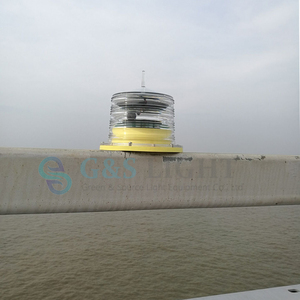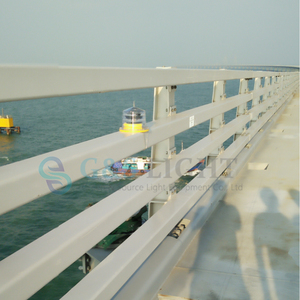
All categories
Featured selections
Trade Assurance
Buyer Central
Help Center
Get the app
Become a supplier

(1507 products available)














































Low-intensity obstacle lights are aviation lights installed on tall structures to warn birds and aircraft of potential hazards. There are various types of low-intensity lights for obstacles, as explained below:
Red Lights
These are classified as low-intensity lights because they emit a less bright light than high-intensity lights. They are used during nighttime when the ambient light is low. Red lights are preferred because they are less likely to cause glare or fatigue to pilots. They are designed to meet FAA specifications.
LED Lights
These lights are created using light-emitting diodes. They are considered low-intensity red obstacle lights because they have a longer lifespan and are more energy-efficient than traditional lighting options such as incandescent lights. LED lights are known for their brightness, which enhances visibility. They are ideal for use in various weather conditions.
Combination Lights
These lights are considered low-intensity lights for obstacles because they combine red and white lighting. They are ideal for use in both day and night. The combination of red and white lights ensures compliance with aviation regulations. They enhance the visibility of tall structures to birds and aircraft during any time of the day.
Solar-Powered Lights
These low-intensity lights use solar panels to capture and store energy from the sun. They are popular in remote areas where there is no electricity. Solar-powered lights are more sustainable and cost-effective over time. They operate efficiently in various weather conditions. These lights use energy storage devices to ensure they operate even when there is no sunlight.
Blinking or Flashing Lights
These are regarded as low-intensity lights because they emit a light that is interrupted by a flash or a blink. The blinking or flashing sequence draws attention and is important for heightening awareness among pilots. These lights can be integrated with steady-burning lights.
Low-Intensity Dual Lights
These are classified as low-intensity lights because they are designed to fulfill the criteria for both low and high-intensity lights. They automatically adjust their brightness depending on the ambient light conditions. They can switch between low-intensity red light at night and high-intensity white light during the day.
Low-intensity lights have different features that offer various benefits to pilots and ground crews. These features enhance safety, visibility, and ease of use. Here are some common features and their functions.
LED Technology
Low-intensity lights that use LED technology have high brightness with low power consumption. They have a long lifespan, which reduces maintenance costs and time. Also, these lights have uniform illumination, which improves the visibility of the marking and enhances safety.
Solar Power
Some low-intensity lights are equipped with solar panels. The panels provide solar-powered lights that have batteries for storage. The lights can be installed in remote areas that have no electricity. Solar-powered lights have low operational costs and are eco-friendly, which reduces carbon footprint.
Flash or Blink
Obstacle lights can either flash or blink. The intermittent lighting makes the lights more visible and draws the attention of pilots. They are especially useful in low-light and low-visibility conditions. Flashing or blinking lights can help reduce fatigue and improve awareness.
Multiple Mounting Options
Low-intensity lights have several mounting options. Mounting options include pipe mounting, flange mounting, or magnetic mounting. The diversity in mounting options makes it easy to install the lights in different locations and positions.
Durable Construction
Low-intensity lights are manufactured with materials like polycarbonate or aluminum. This ensures the lights are resistant to impacts, harsh weather, and corrosion. The durable construction materials increase the lifespan of the lights and make them reliable.
Adjustable Settings
Some low-intensity lights have adjustable settings. This allows users to adjust the brightness level according to their needs. The lights can be set to a higher brightness level during the day and a lower level at night. Adjustable settings offer versatility and enhance energy efficiency.
Battery Backup
Obstacle lights can be equipped with battery backups. The battery backup ensures the light continues operating during power outages. This enhances the reliability of the lights and ensures continuous visibility and safety.
Low-intensity obstacle lights are used in various industries and sectors to enhance safety and visibility. Here are some common use cases:
Aviation
Low-intensity red obstruction lights are commonly used on towers and wind turbines for aviation safety. The lights help prevent aircraft collisions by alerting pilots to the presence of tall structures. These lights are typically mounted at the top of the structure and may be powered by solar energy in remote locations.
Maritime
These lights are used on buoys, markers and structures in waterways to enhance visibility for ships and boats. They are designed to meet specific maritime regulations and standards, ensuring the safety of marine navigation.
Construction
Low-intensity red lights are often placed on temporary structures, cranes and construction sites to prevent collisions with aircraft. These lights play a crucial role in ensuring the safety of ongoing construction projects and nearby air traffic.
Telecommunication
Obstruction lights are commonly used on radio and communication towers to enhance visibility. These lights help prevent collisions and ensure the safety of birds and aircraft. They are essential for the safety of air traffic and the protection of tall structures.
Wind Energy
These lights are also placed on wind turbines to indicate their height to flying birds and aircraft. The lights are typically powered by the turbine's own energy, making them self-sustaining and eco-friendly.
Solar Applications
Low-intensity obstacle lights are available in solar-powered variants, making them suitable for remote locations without access to electricity. Solar-powered lights are environmentally friendly and cost-effective in the long run.
High-Rise Buildings
In some cases, high-rise buildings may incorporate lighting systems on their rooftops to prevent bird collisions. These lighting systems may include low-intensity lights and other visual deterrents to ensure the safety of birds and air traffic.
There are several factors one must consider when choosing the appropriate low-intensity obstacle lights, including:
Compliance with regulations
The first thing to check is whether the lights comply with aviation regulations. This ensures that the lights are not only legally mandated but also function effectively. For instance, specific regulations may necessitate certain light colors or intensity levels. These can be checked with the relevant authorities. Also, some regulations provide guidelines on the installation and maintenance of these lights. Adhering to such regulations enhances the safety and visibility of the structures. It also minimizes legal liabilities for the manufacturers. That said, it is important to note that regulations may differ by country or region. Therefore, it is important to consult the local authorities to determine the necessary requirements.
Color and light intensity
The two main color options for low-intensity lights are red and white. Red lights are preferred for areas near airports. This is because they are less likely to interfere with the nocturnal wildlife. On the other hand, white lights are suitable for areas with high ambient light. Also, manufacturers should choose lights with intensity levels that meet regulatory requirements. Additionally, the chosen intensity should be appropriate for the structure's height and location.
Beam angle
The beam angle refers to the light's distribution. This is the area where the light is cast. A narrow beam angle is suitable for directing light to specific areas. On the contrary, a wide beam angle illuminates a larger area. Buyers should choose the appropriate beam angle to ensure adequate visibility. This is depending on the structure's height and the required coverage area.
Power source
Low-intensity obstacle lights can be powered by different sources. These include AC mains, solar energy or batteries. The choice of the power source depends on various factors. These include the location of the obstacle, availability of electricity and environmental conditions. For instance, solar-powered lights are suitable for remote areas. They are also cost-effective and environmentally friendly.
Durability
Durability is an important factor when choosing low-intensity obstacle lights. The lights are usually installed in areas with harsh weather conditions. Therefore, manufacturers should look for lights built with high-quality materials. Ideally, the materials should have excellent corrosion and impact resistance. This ensures the lights can withstand extreme temperatures, UV exposure and adverse weather elements.
Q1: What is the main purpose of low-intensity obstacle lights?
A1: These lights are used to mark obstacles and hazards to low-flying aircraft. They help improve aviation safety by increasing the visibility of obstacles.
Q2: What color is typically emitted by low-intensity lights?
A2: Red is the typical color emitted by low-intensity lights. Red lights are used during nighttime conditions. White lights are also used during the daytime or when the red light is not visible.
Q3: How are low-intensity lights powered?
A3: Low-intensity lights can be powered by the electrical grid. They can also be equipped with solar panels to enable them to use solar energy. When powered by the electrical grid, they will require a backup battery system.
Q4: How often should low-intensity lights be maintained?
A4: The lights should be inspected regularly to ensure they are functioning as required. They should be maintained at least once every six months. However, the maintenance frequency can be affected by the installation environment. For instance, installations in dusty areas will require more frequent maintenance to remove any debris from the light.
Q5: Are low-intensity lights suitable for all types of obstacles?
A5: The lights are suitable for obstacles that require marking for aviation safety. This includes communication towers, wind turbines, power transmission lines, and other tall structures. However, high-intensity lights are suitable for marking obstacles that are 200 feet or taller.